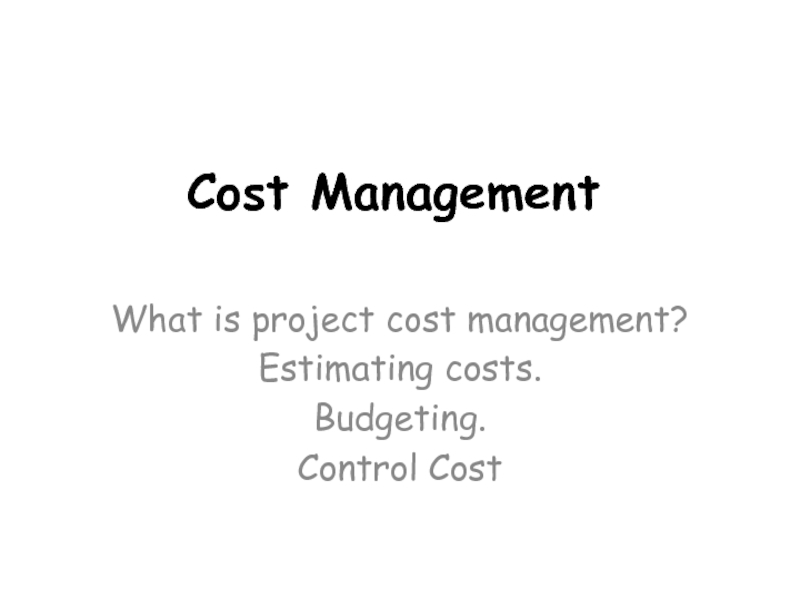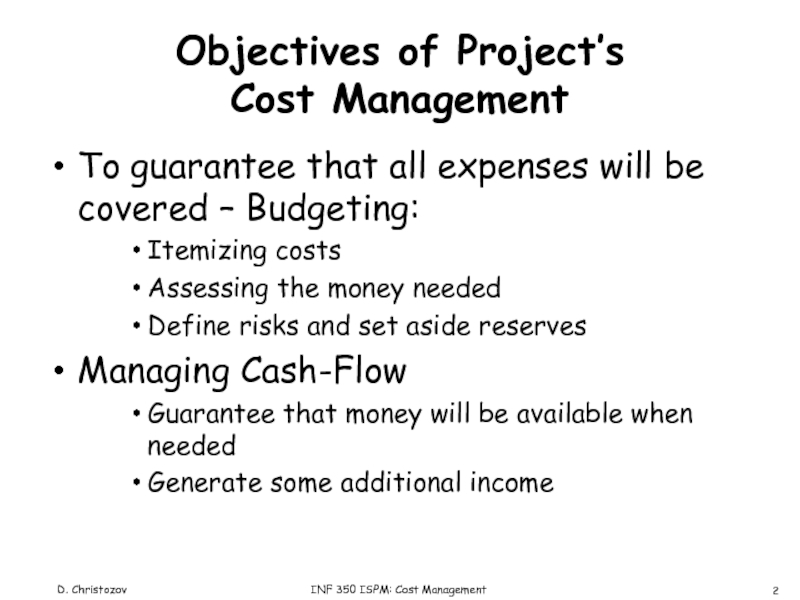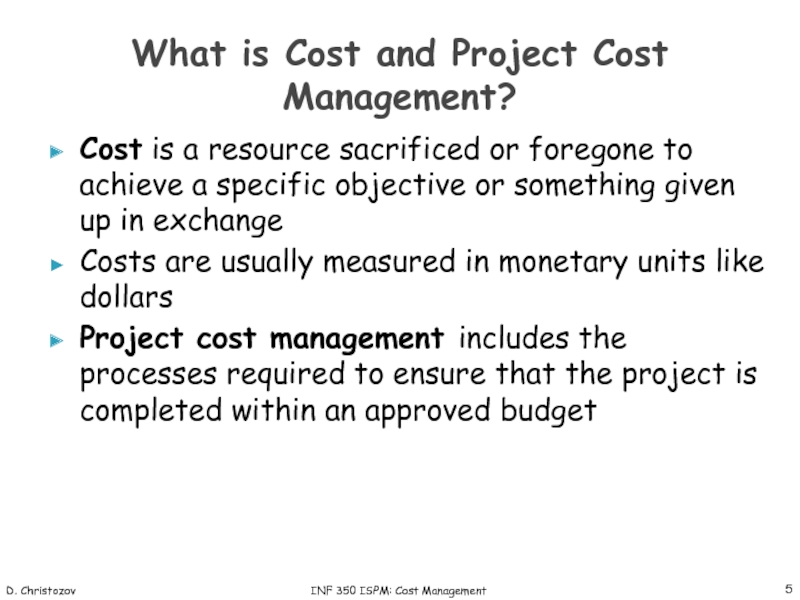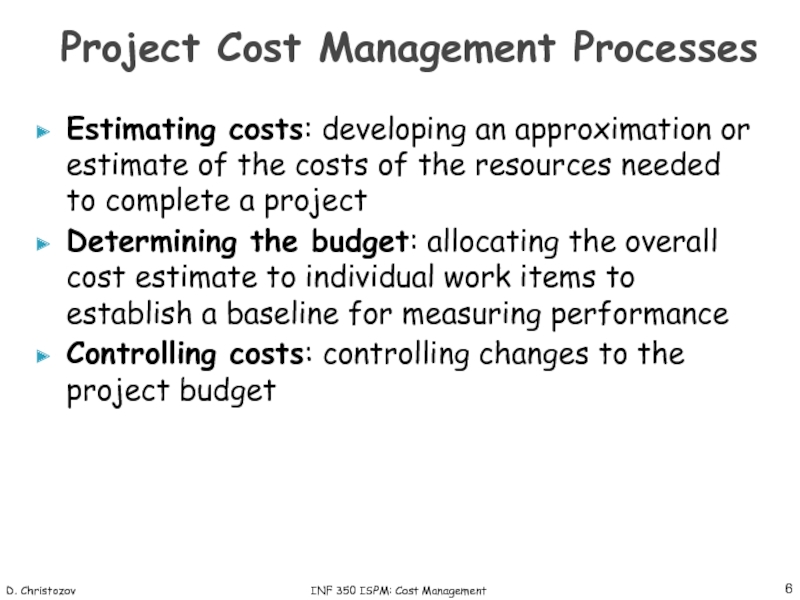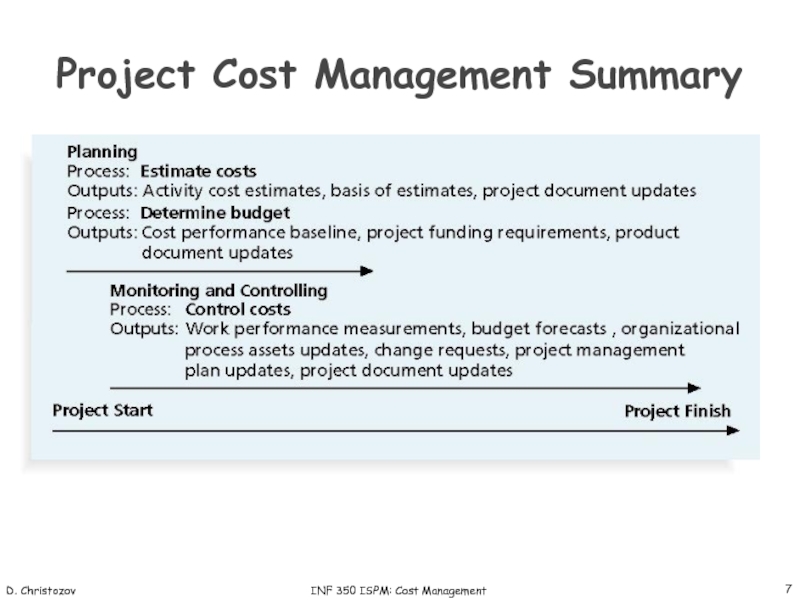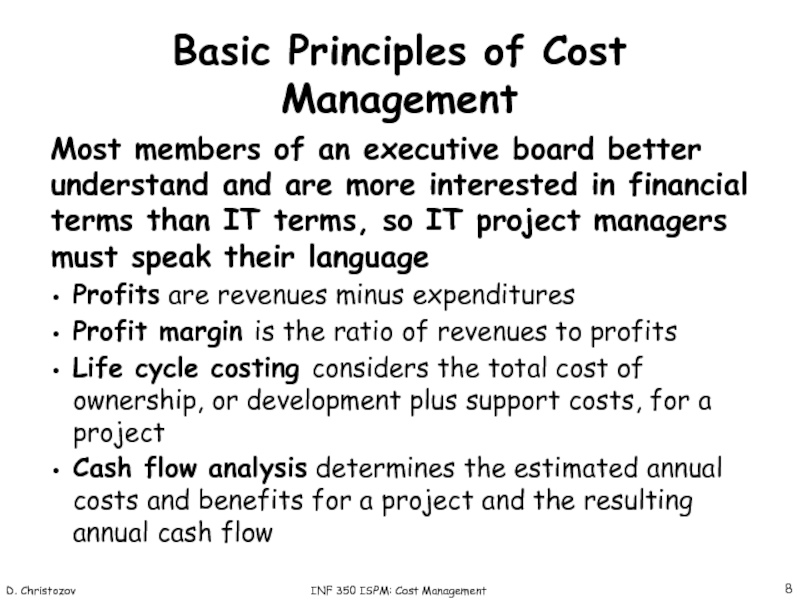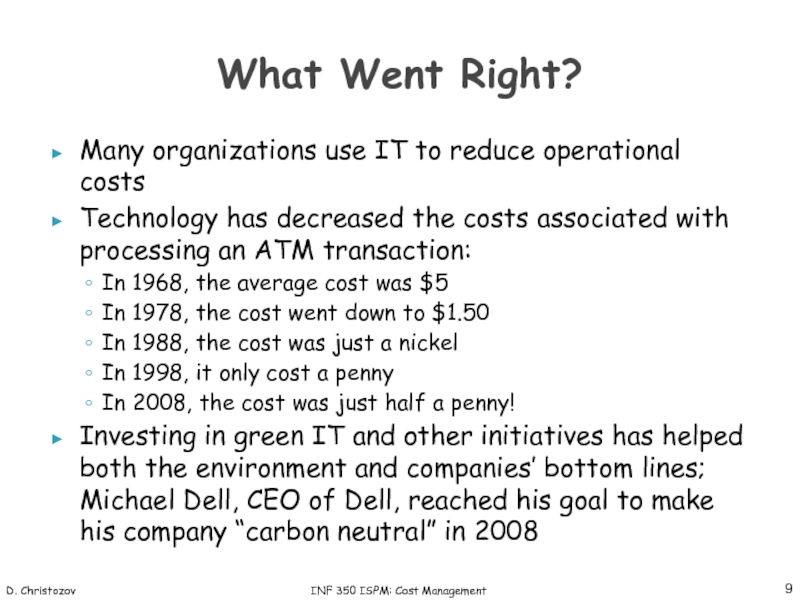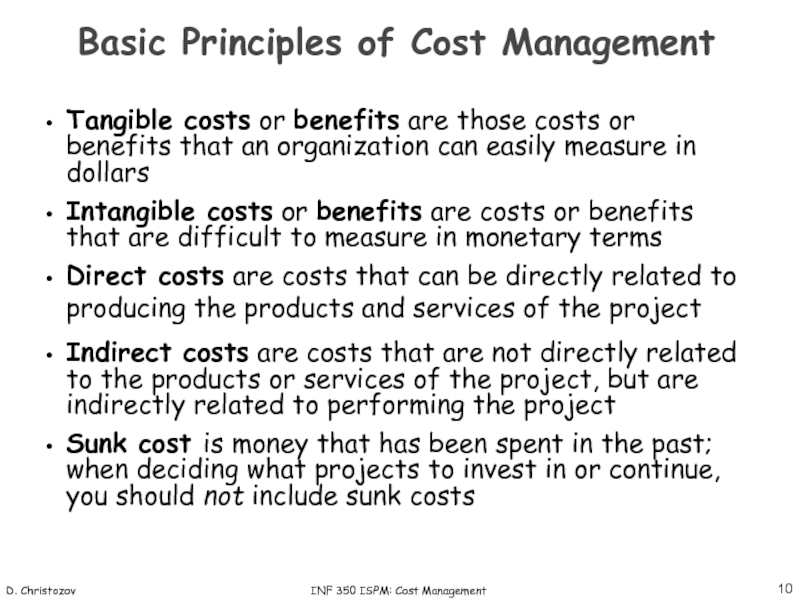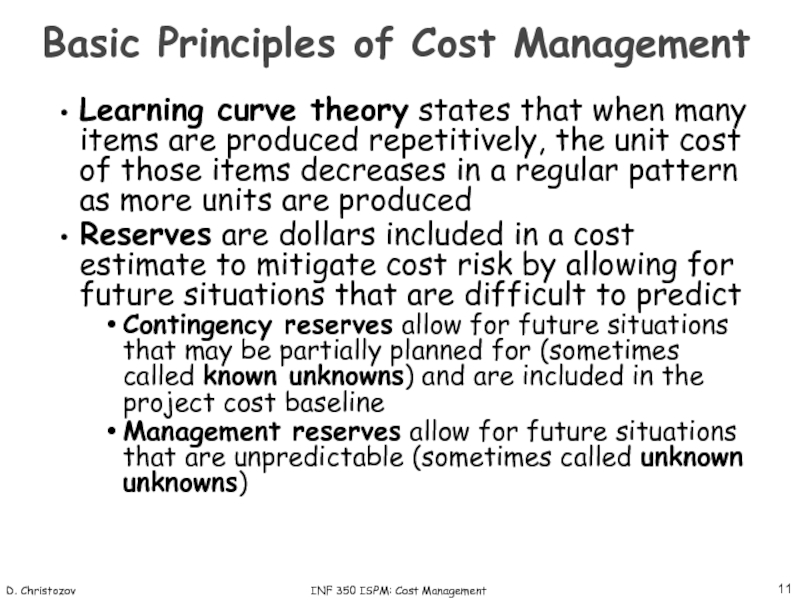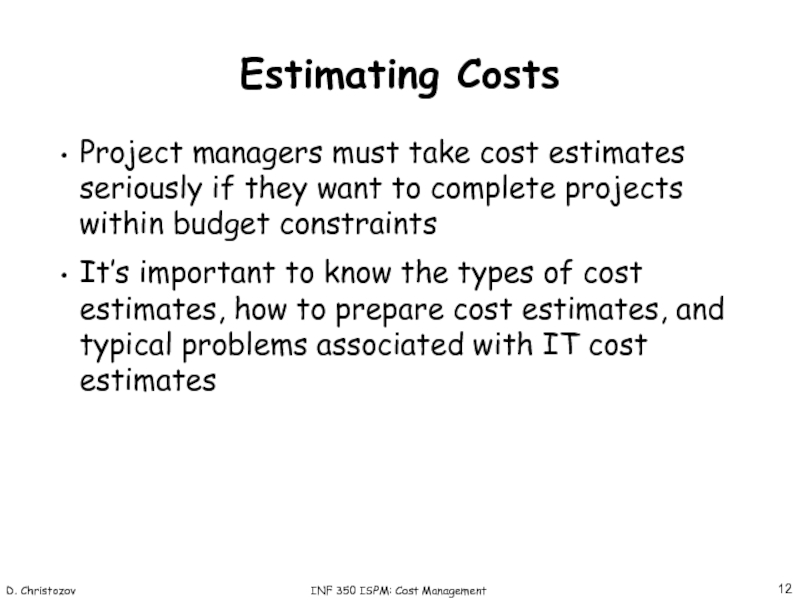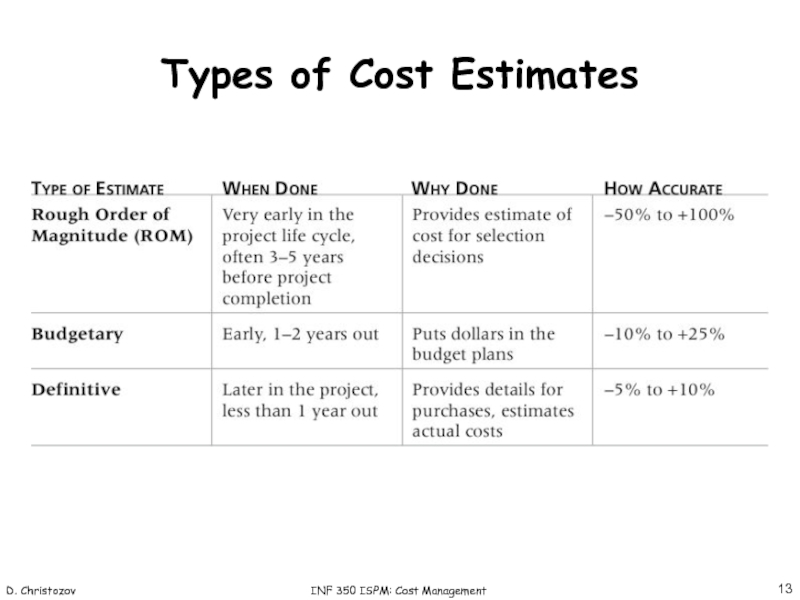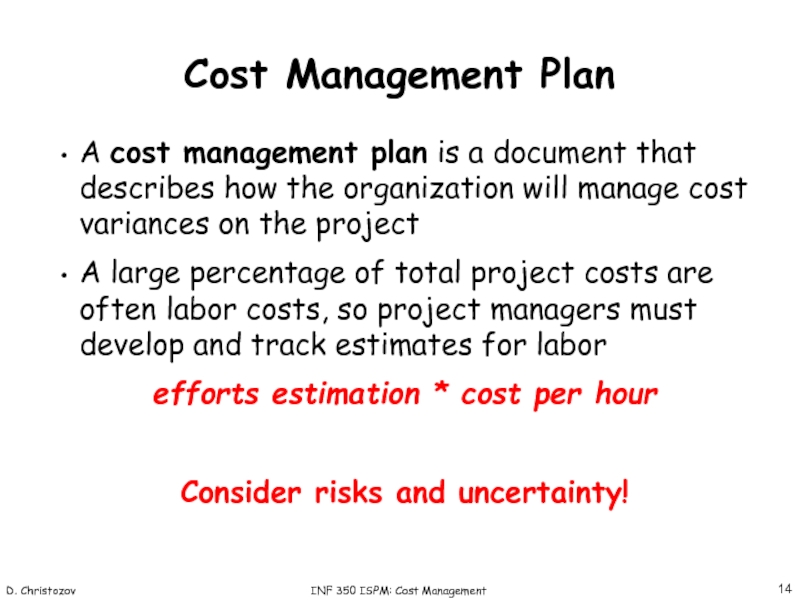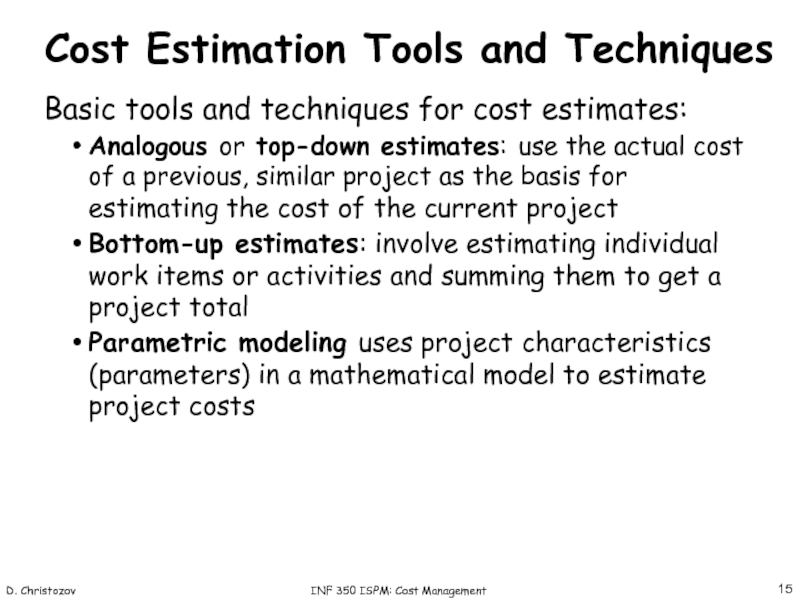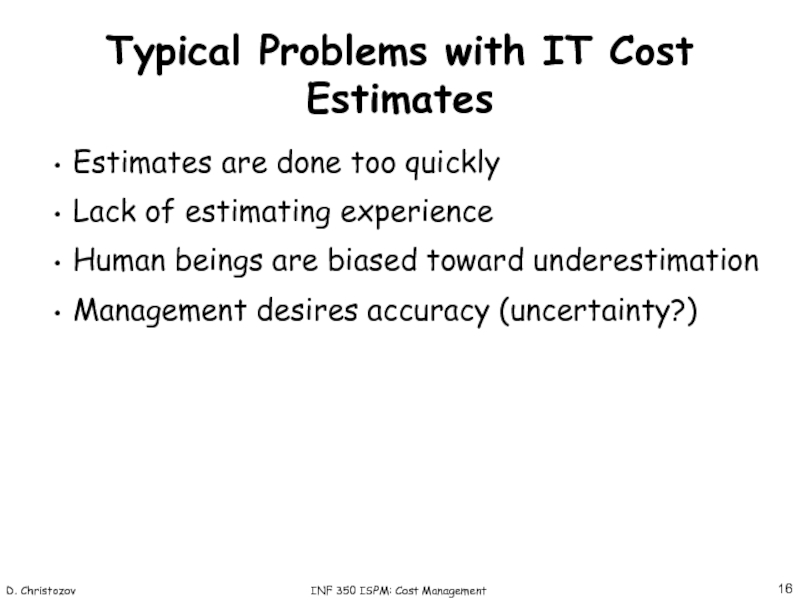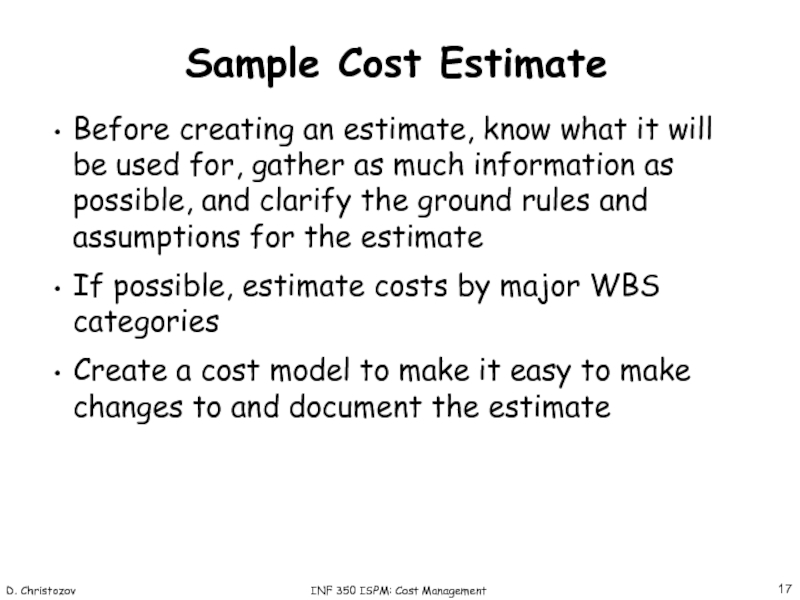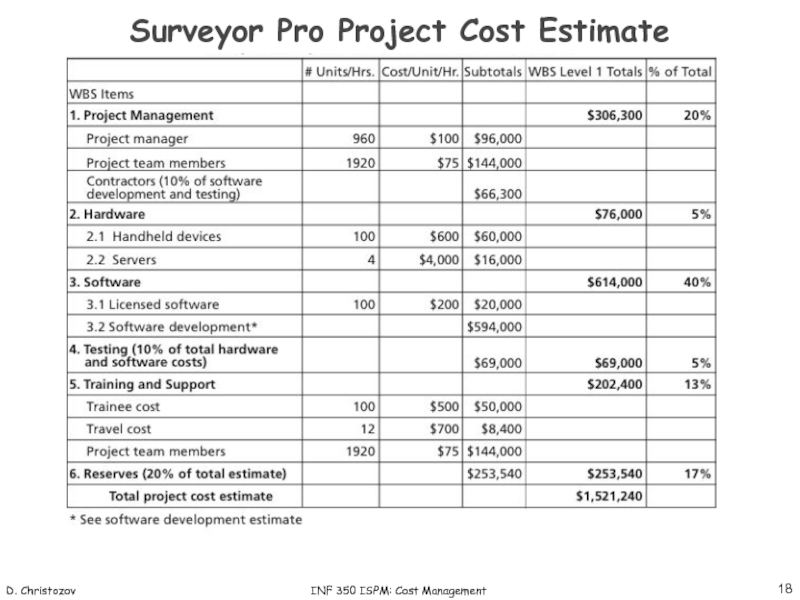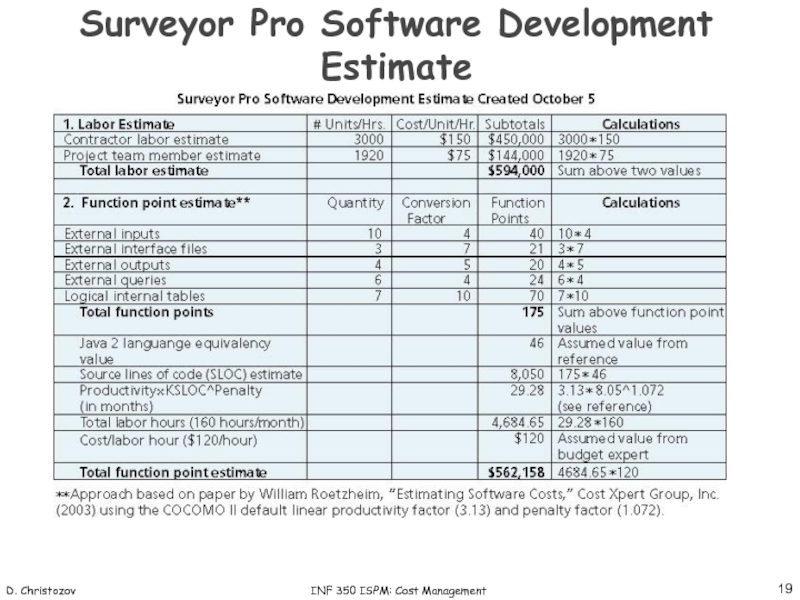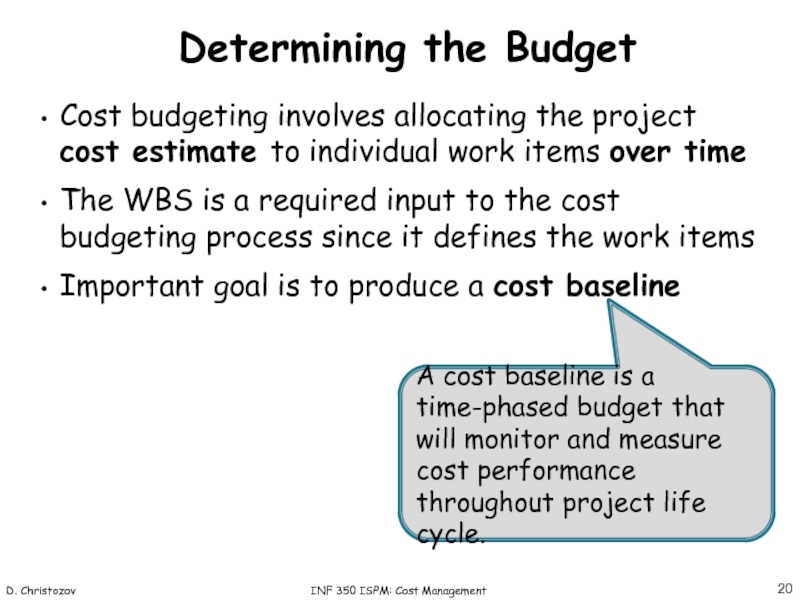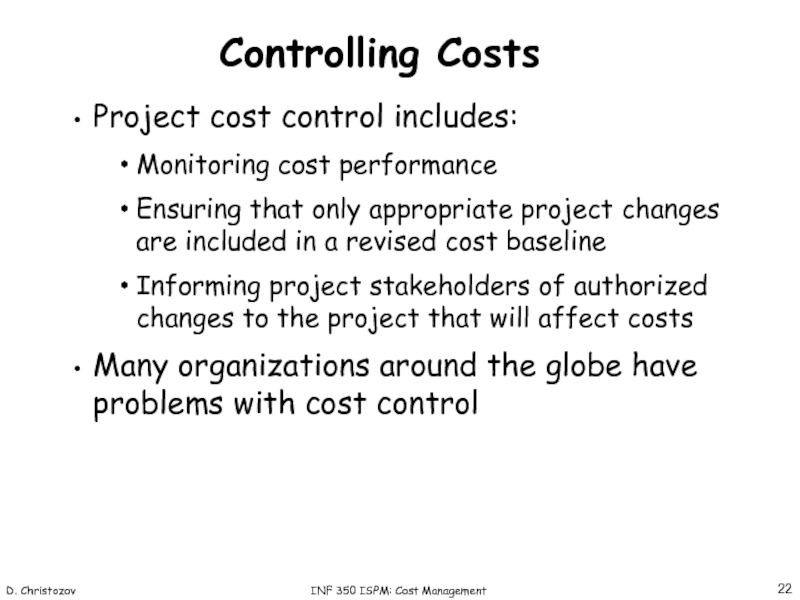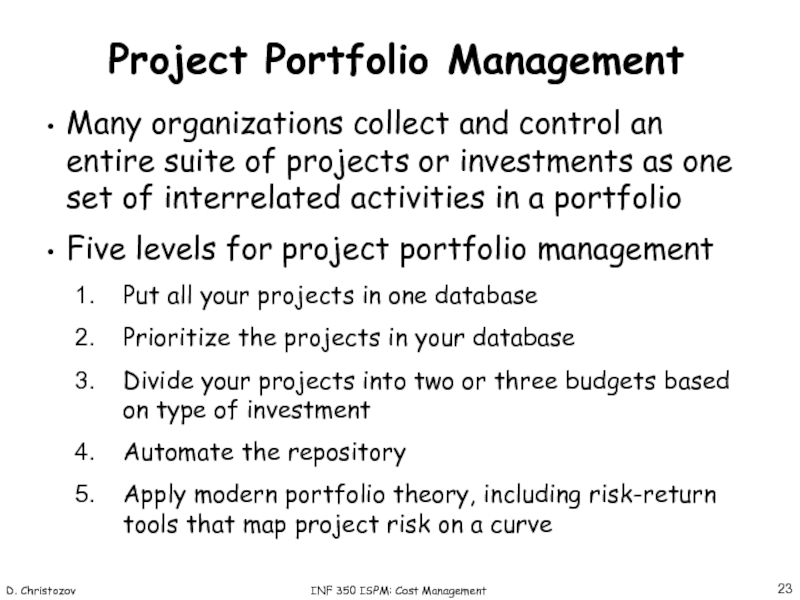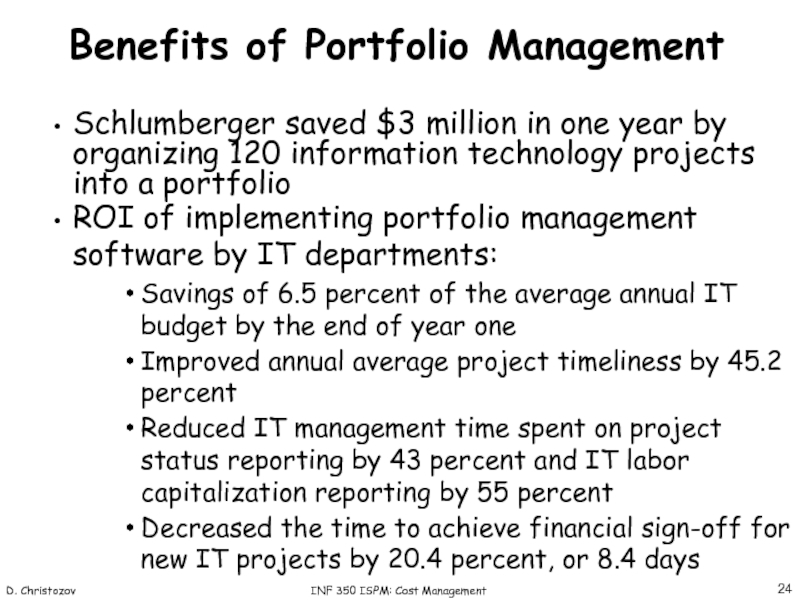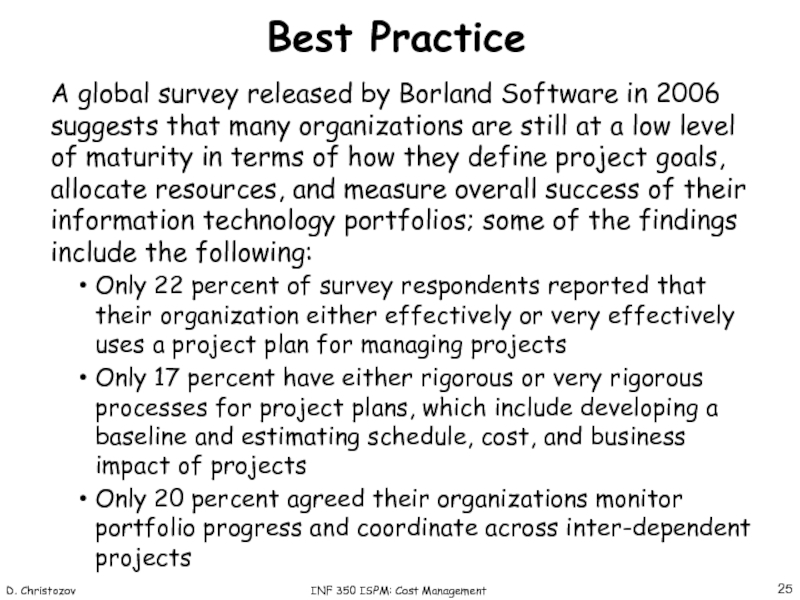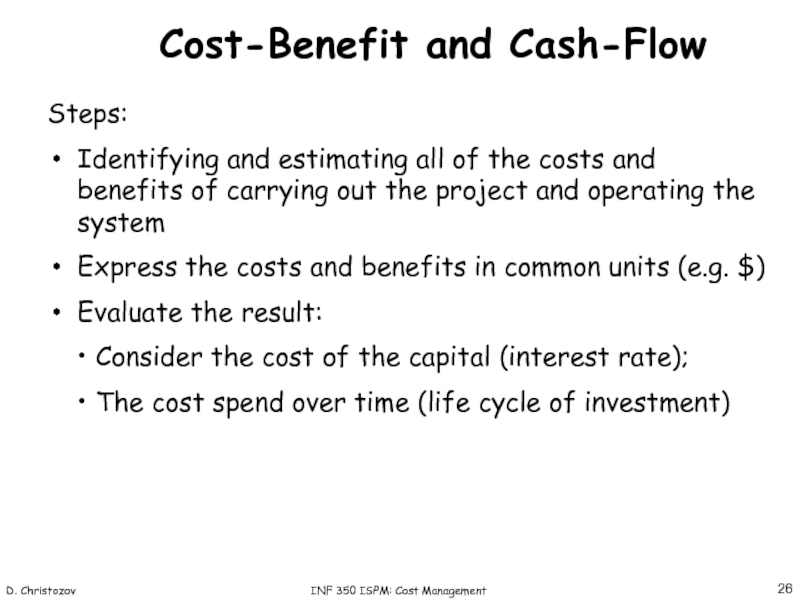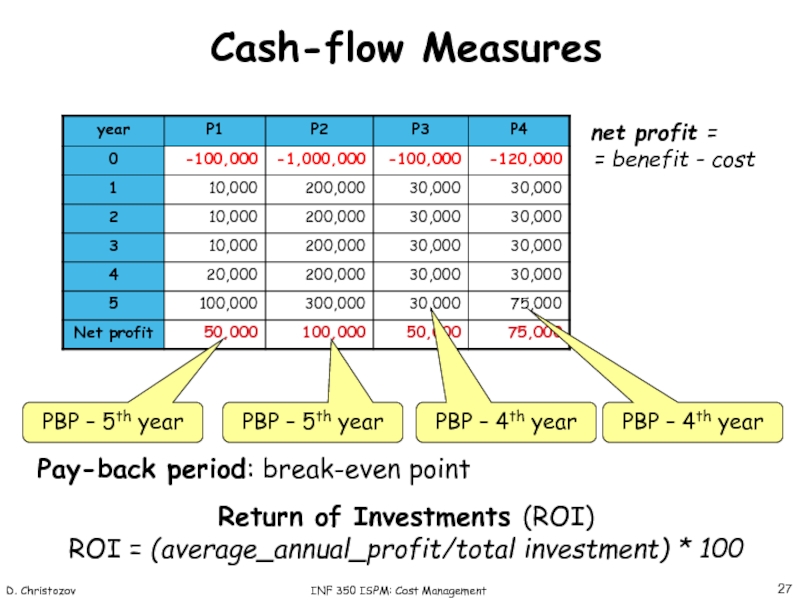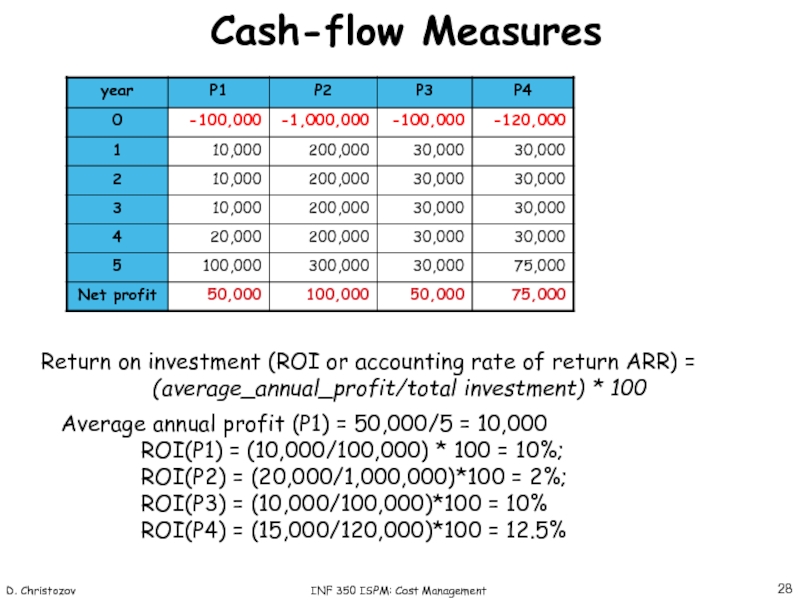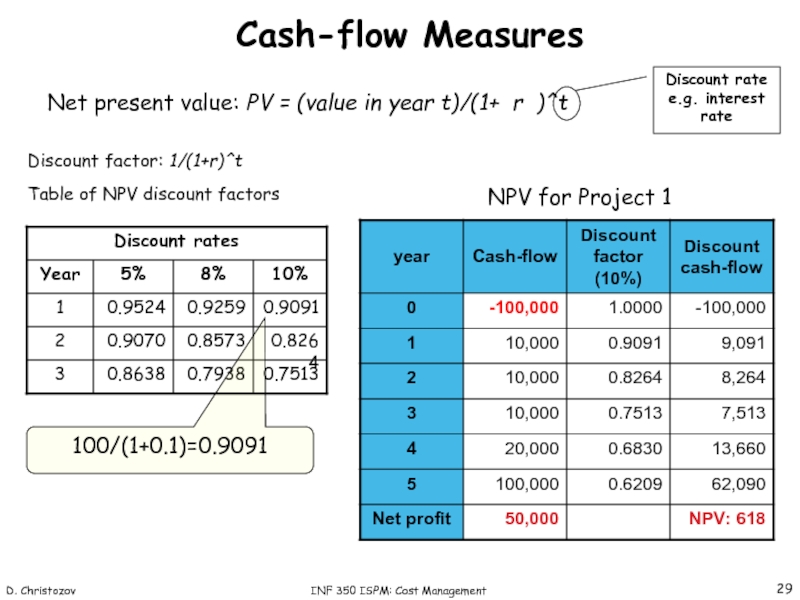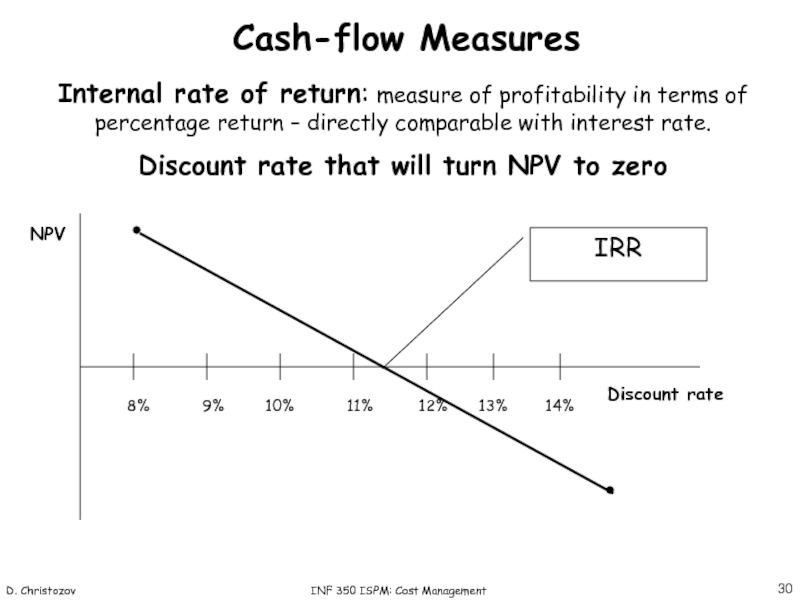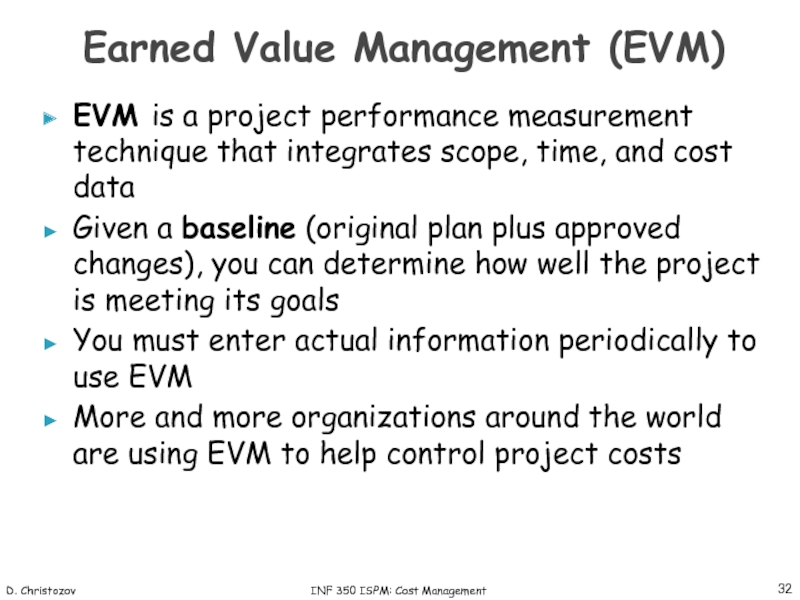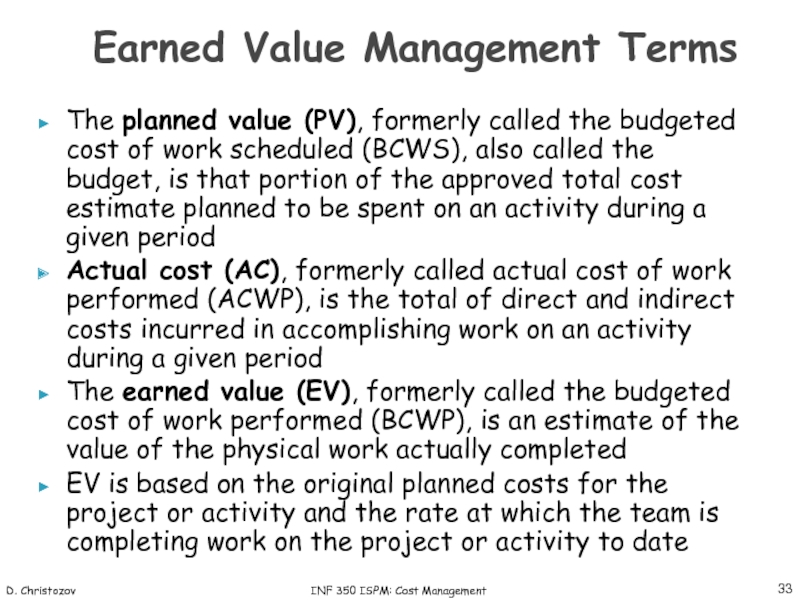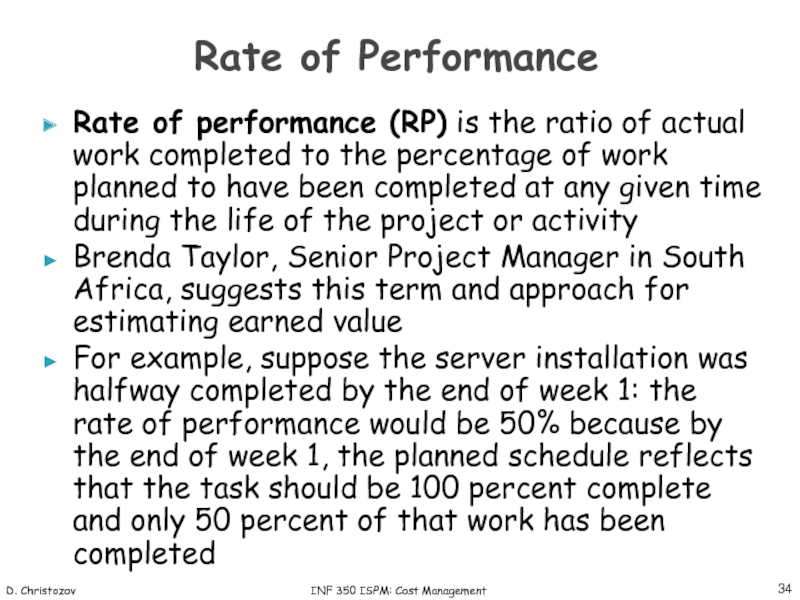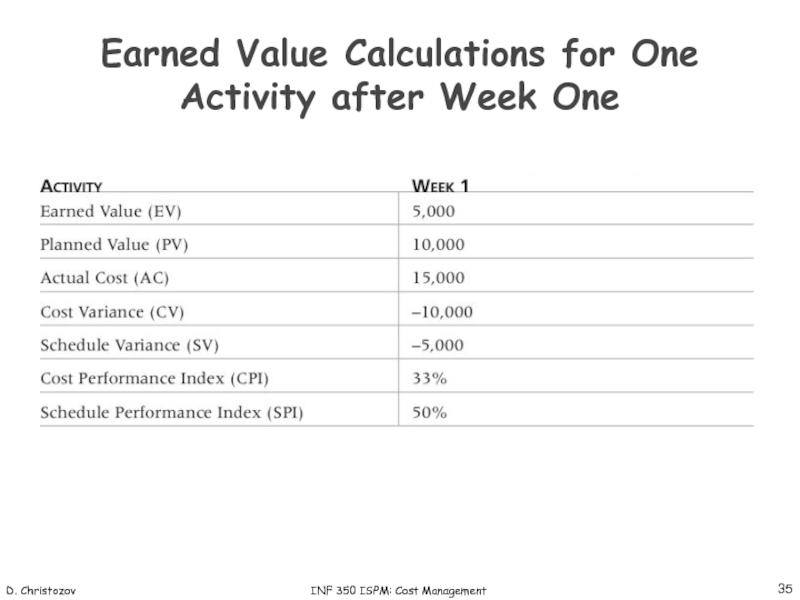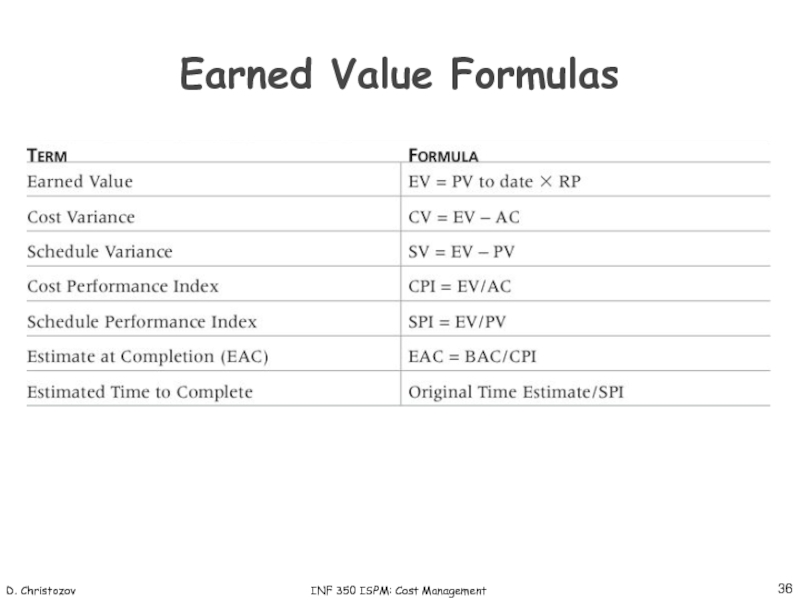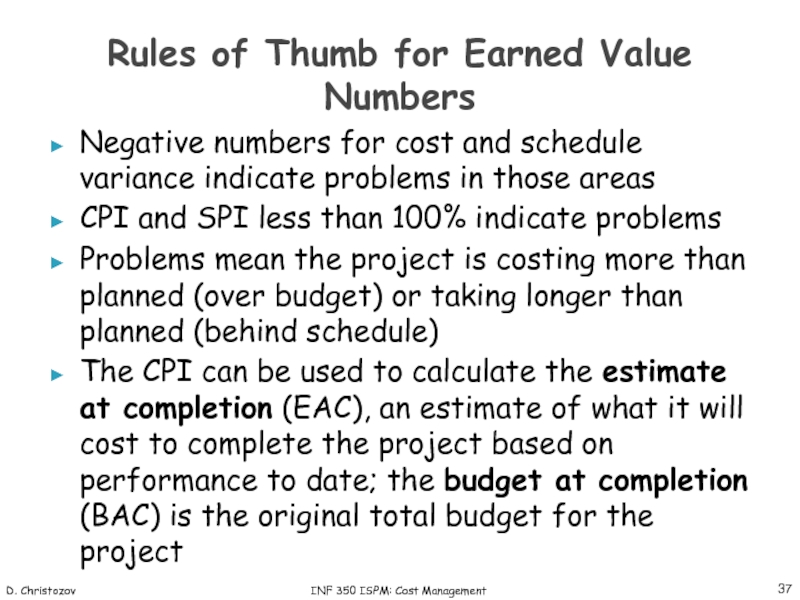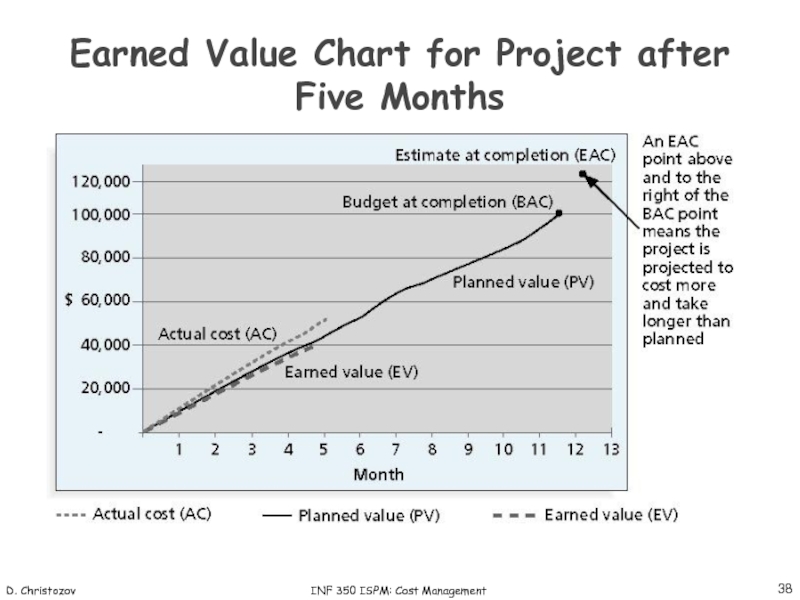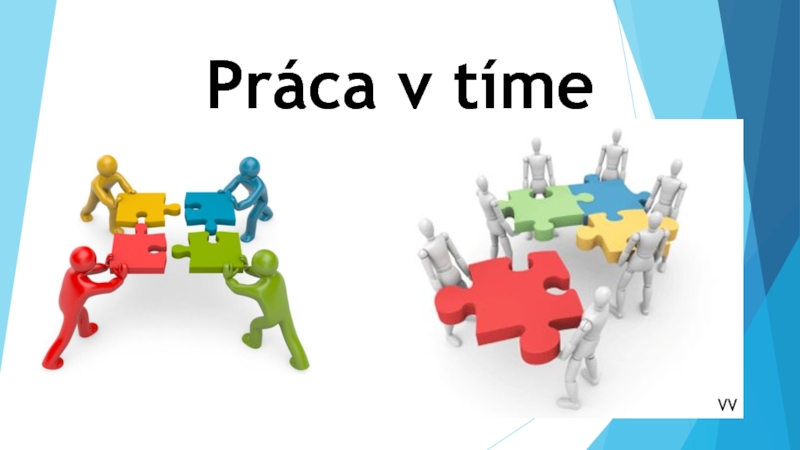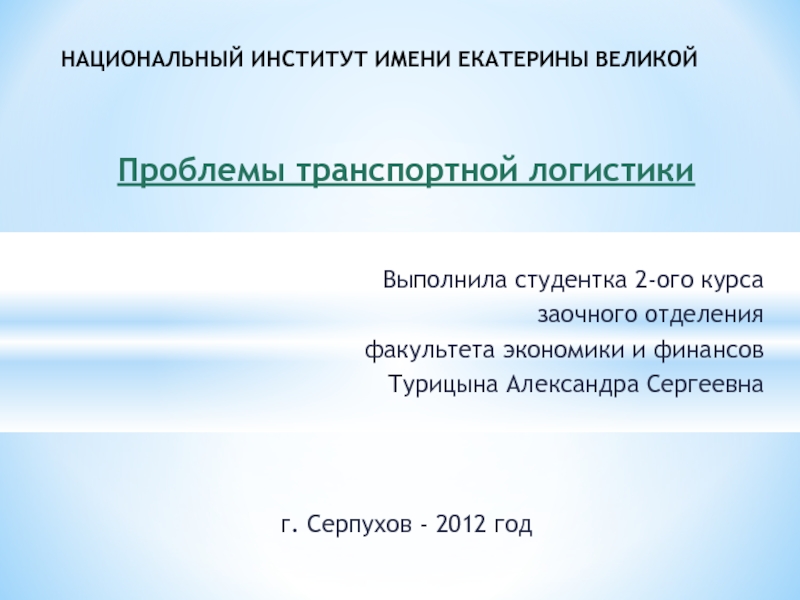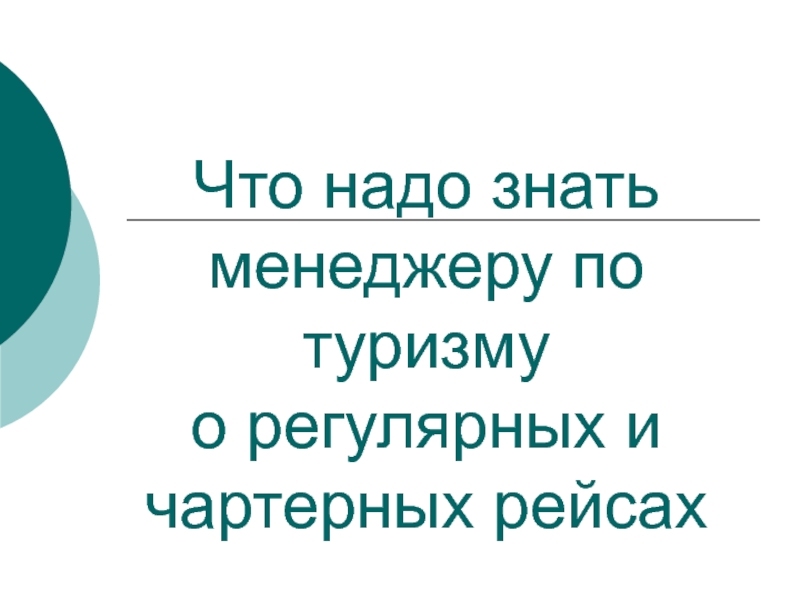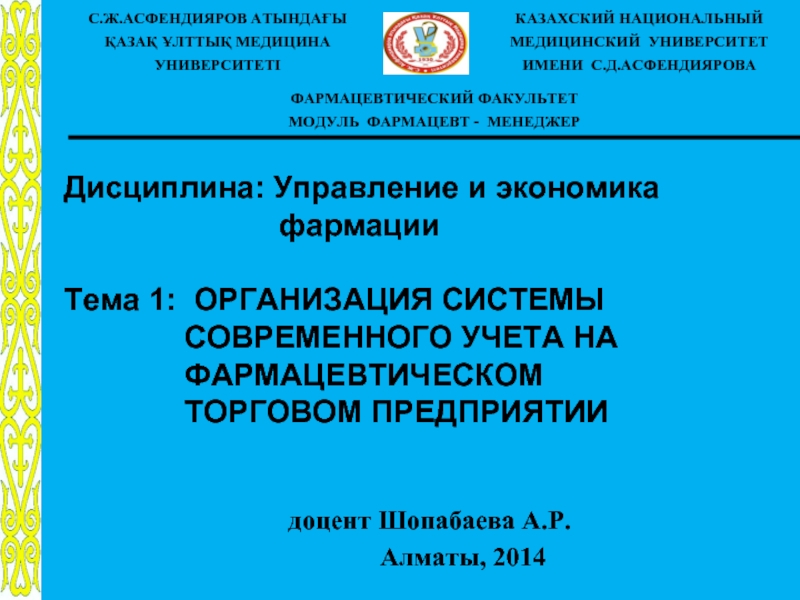- Главная
- Разное
- Дизайн
- Бизнес и предпринимательство
- Аналитика
- Образование
- Развлечения
- Красота и здоровье
- Финансы
- Государство
- Путешествия
- Спорт
- Недвижимость
- Армия
- Графика
- Культурология
- Еда и кулинария
- Лингвистика
- Английский язык
- Астрономия
- Алгебра
- Биология
- География
- Детские презентации
- Информатика
- История
- Литература
- Маркетинг
- Математика
- Медицина
- Менеджмент
- Музыка
- МХК
- Немецкий язык
- ОБЖ
- Обществознание
- Окружающий мир
- Педагогика
- Русский язык
- Технология
- Физика
- Философия
- Химия
- Шаблоны, картинки для презентаций
- Экология
- Экономика
- Юриспруденция
Cost Management презентация
Содержание
- 1. Cost Management
- 2. Objectives of Project’s Cost Management To
- 3. D. Christozov INF 350 ISPM: Cost Management
- 4. D. Christozov INF 350 ISPM: Cost Management
- 5. D. Christozov INF 350 ISPM: Cost Management
- 6. D. Christozov INF 350 ISPM: Cost Management
- 7. D. Christozov INF 350 ISPM: Cost Management Project Cost Management Summary
- 8. D. Christozov INF 350 ISPM: Cost Management
- 9. D. Christozov INF 350 ISPM: Cost Management
- 10. D. Christozov INF 350 ISPM: Cost Management
- 11. D. Christozov INF 350 ISPM: Cost Management
- 12. D. Christozov INF 350 ISPM: Cost Management
- 13. D. Christozov INF 350 ISPM: Cost Management Types of Cost Estimates
- 14. D. Christozov INF 350 ISPM: Cost Management
- 15. D. Christozov INF 350 ISPM: Cost Management
- 16. D. Christozov INF 350 ISPM: Cost Management
- 17. D. Christozov INF 350 ISPM: Cost Management
- 18. D. Christozov INF 350 ISPM: Cost Management Surveyor Pro Project Cost Estimate
- 19. D. Christozov INF 350 ISPM: Cost Management Surveyor Pro Software Development Estimate
- 20. D. Christozov INF 350 ISPM: Cost Management
- 21. D. Christozov INF 350 ISPM: Cost Management Surveyor Pro Project Cost Baseline
- 22. D. Christozov INF 350 ISPM: Cost Management
- 23. D. Christozov INF 350 ISPM: Cost Management
- 24. D. Christozov INF 350 ISPM: Cost Management
- 25. D. Christozov INF 350 ISPM: Cost Management
- 26. D. Christozov INF 350 ISPM: Cost Management
- 27. D. Christozov INF 350 ISPM: Cost Management
- 28. D. Christozov INF 350 ISPM: Cost Management
- 29. D. Christozov INF 350 ISPM: Cost Management
- 30. D. Christozov INF 350 ISPM: Cost Management
- 31. D. Christozov INF 270 PIS: Change Management
- 32. D. Christozov INF 350 ISPM: Cost Management
- 33. D. Christozov INF 350 ISPM: Cost Management
- 34. D. Christozov INF 350 ISPM: Cost Management
- 35. D. Christozov INF 350 ISPM: Cost Management
- 36. D. Christozov INF 350 ISPM: Cost Management Earned Value Formulas
- 37. D. Christozov INF 350 ISPM: Cost Management
- 38. D. Christozov INF 350 ISPM: Cost Management Earned Value Chart for Project after Five Months
Слайд 2Objectives of Project’s
Cost Management
To guarantee that all expenses will be
Itemizing costs
Assessing the money needed
Define risks and set aside reserves
Managing Cash-Flow
Guarantee that money will be available when needed
Generate some additional income
D. Christozov
INF 350 ISPM: Cost Management
Слайд 3D. Christozov
INF 350 ISPM: Cost Management
IT projects have a poor track
The CHAOS studies found the average cost overrun (the additional percentage or dollar amount by which actual costs exceed estimates) ranged from 180 percent in 1994 to 56 percent in 2004; other studies found overruns to be 33-34 percent
The Importance of Project Cost Management
Слайд 4D. Christozov
INF 350 ISPM: Cost Management
The U.S. government, especially the Internal
A series of project failures by the IRS in the 1990s cost taxpayers more than $50 billion a year
In 2006, the IRS was in the news for a botched upgrade to its fraud-detection software, costing $318 million in fraudulent refunds that didn’t get caught
A 2008 Government Accountability Office (GAO) report stated that more than 400 U.S. government agency IT projects, worth an estimated $25 billion, suffer from poor planning and underperformance
The United Kingdom’s National Health Service IT modernization program was called the greatest IT disaster in history with an estimated $26 billion overrun
What Went Wrong?
Слайд 5D. Christozov
INF 350 ISPM: Cost Management
Cost is a resource sacrificed or
Costs are usually measured in monetary units like dollars
Project cost management includes the processes required to ensure that the project is completed within an approved budget
What is Cost and Project Cost Management?
Слайд 6D. Christozov
INF 350 ISPM: Cost Management
Estimating costs: developing an approximation or
Determining the budget: allocating the overall cost estimate to individual work items to establish a baseline for measuring performance
Controlling costs: controlling changes to the project budget
Project Cost Management Processes
Слайд 8D. Christozov
INF 350 ISPM: Cost Management
Most members of an executive board
Profits are revenues minus expenditures
Profit margin is the ratio of revenues to profits
Life cycle costing considers the total cost of ownership, or development plus support costs, for a project
Cash flow analysis determines the estimated annual costs and benefits for a project and the resulting annual cash flow
Basic Principles of Cost Management
Слайд 9D. Christozov
INF 350 ISPM: Cost Management
Many organizations use IT to reduce
Technology has decreased the costs associated with processing an ATM transaction:
In 1968, the average cost was $5
In 1978, the cost went down to $1.50
In 1988, the cost was just a nickel
In 1998, it only cost a penny
In 2008, the cost was just half a penny!
Investing in green IT and other initiatives has helped both the environment and companies’ bottom lines; Michael Dell, CEO of Dell, reached his goal to make his company “carbon neutral” in 2008
What Went Right?
Слайд 10D. Christozov
INF 350 ISPM: Cost Management
Tangible costs or benefits are those
Intangible costs or benefits are costs or benefits that are difficult to measure in monetary terms
Direct costs are costs that can be directly related to producing the products and services of the project
Indirect costs are costs that are not directly related to the products or services of the project, but are indirectly related to performing the project
Sunk cost is money that has been spent in the past; when deciding what projects to invest in or continue, you should not include sunk costs
Basic Principles of Cost Management
Слайд 11D. Christozov
INF 350 ISPM: Cost Management
Learning curve theory states that when
Reserves are dollars included in a cost estimate to mitigate cost risk by allowing for future situations that are difficult to predict
Contingency reserves allow for future situations that may be partially planned for (sometimes called known unknowns) and are included in the project cost baseline
Management reserves allow for future situations that are unpredictable (sometimes called unknown unknowns)
Basic Principles of Cost Management
Слайд 12D. Christozov
INF 350 ISPM: Cost Management
Project managers must take cost estimates
It’s important to know the types of cost estimates, how to prepare cost estimates, and typical problems associated with IT cost estimates
Estimating Costs
Слайд 14D. Christozov
INF 350 ISPM: Cost Management
A cost management plan is a
A large percentage of total project costs are often labor costs, so project managers must develop and track estimates for labor
efforts estimation * cost per hour
Consider risks and uncertainty!
Cost Management Plan
Слайд 15D. Christozov
INF 350 ISPM: Cost Management
Basic tools and techniques for cost
Analogous or top-down estimates: use the actual cost of a previous, similar project as the basis for estimating the cost of the current project
Bottom-up estimates: involve estimating individual work items or activities and summing them to get a project total
Parametric modeling uses project characteristics (parameters) in a mathematical model to estimate project costs
Cost Estimation Tools and Techniques
Слайд 16D. Christozov
INF 350 ISPM: Cost Management
Estimates are done too quickly
Lack of
Human beings are biased toward underestimation
Management desires accuracy (uncertainty?)
Typical Problems with IT Cost Estimates
Слайд 17D. Christozov
INF 350 ISPM: Cost Management
Before creating an estimate, know what
If possible, estimate costs by major WBS categories
Create a cost model to make it easy to make changes to and document the estimate
Sample Cost Estimate
Слайд 20D. Christozov
INF 350 ISPM: Cost Management
Cost budgeting involves allocating the project
The WBS is a required input to the cost budgeting process since it defines the work items
Important goal is to produce a cost baseline
Determining the Budget
A cost baseline is a time-phased budget that will monitor and measure cost performance throughout project life cycle.
Слайд 22D. Christozov
INF 350 ISPM: Cost Management
Project cost control includes:
Monitoring cost performance
Ensuring
Informing project stakeholders of authorized changes to the project that will affect costs
Many organizations around the globe have problems with cost control
Controlling Costs
Слайд 23D. Christozov
INF 350 ISPM: Cost Management
Many organizations collect and control an
Five levels for project portfolio management
Put all your projects in one database
Prioritize the projects in your database
Divide your projects into two or three budgets based on type of investment
Automate the repository
Apply modern portfolio theory, including risk-return tools that map project risk on a curve
Project Portfolio Management
Слайд 24D. Christozov
INF 350 ISPM: Cost Management
Schlumberger saved $3 million in one
ROI of implementing portfolio management software by IT departments:
Savings of 6.5 percent of the average annual IT budget by the end of year one
Improved annual average project timeliness by 45.2 percent
Reduced IT management time spent on project status reporting by 43 percent and IT labor capitalization reporting by 55 percent
Decreased the time to achieve financial sign-off for new IT projects by 20.4 percent, or 8.4 days
Benefits of Portfolio Management
Слайд 25D. Christozov
INF 350 ISPM: Cost Management
A global survey released by Borland
Only 22 percent of survey respondents reported that their organization either effectively or very effectively uses a project plan for managing projects
Only 17 percent have either rigorous or very rigorous processes for project plans, which include developing a baseline and estimating schedule, cost, and business impact of projects
Only 20 percent agreed their organizations monitor portfolio progress and coordinate across inter-dependent projects
Best Practice
Слайд 26D. Christozov
INF 350 ISPM: Cost Management
Cost-Benefit and Cash-Flow
Steps:
Identifying and estimating all
Express the costs and benefits in common units (e.g. $)
Evaluate the result:
Consider the cost of the capital (interest rate);
The cost spend over time (life cycle of investment)
Слайд 27D. Christozov
INF 350 ISPM: Cost Management
Cash-flow Measures
Pay-back period: break-even point
Return of
ROI = (average_annual_profit/total investment) * 100
net profit =
= benefit - cost
PBP – 5th year
PBP – 5th year
PBP – 4th year
PBP – 4th year
Слайд 28D. Christozov
INF 350 ISPM: Cost Management
Cash-flow Measures
Return on investment (ROI or
(average_annual_profit/total investment) * 100
Average annual profit (P1) = 50,000/5 = 10,000
ROI(P1) = (10,000/100,000) * 100 = 10%;
ROI(P2) = (20,000/1,000,000)*100 = 2%;
ROI(P3) = (10,000/100,000)*100 = 10%
ROI(P4) = (15,000/120,000)*100 = 12.5%
Слайд 29D. Christozov
INF 350 ISPM: Cost Management
Cash-flow Measures
Net present value: PV =
Discount rate
e.g. interest rate
NPV for Project 1
100/(1+0.1)=0.9091
Слайд 30D. Christozov
INF 350 ISPM: Cost Management
Cash-flow Measures
Internal rate of return: measure
Discount rate that will turn NPV to zero
Слайд 32D. Christozov
INF 350 ISPM: Cost Management
EVM is a project performance measurement
Given a baseline (original plan plus approved changes), you can determine how well the project is meeting its goals
You must enter actual information periodically to use EVM
More and more organizations around the world are using EVM to help control project costs
Earned Value Management (EVM)
Слайд 33D. Christozov
INF 350 ISPM: Cost Management
The planned value (PV), formerly called
Actual cost (AC), formerly called actual cost of work performed (ACWP), is the total of direct and indirect costs incurred in accomplishing work on an activity during a given period
The earned value (EV), formerly called the budgeted cost of work performed (BCWP), is an estimate of the value of the physical work actually completed
EV is based on the original planned costs for the project or activity and the rate at which the team is completing work on the project or activity to date
Earned Value Management Terms
Слайд 34D. Christozov
INF 350 ISPM: Cost Management
Rate of performance (RP) is the
Brenda Taylor, Senior Project Manager in South Africa, suggests this term and approach for estimating earned value
For example, suppose the server installation was halfway completed by the end of week 1: the rate of performance would be 50% because by the end of week 1, the planned schedule reflects that the task should be 100 percent complete and only 50 percent of that work has been completed
Rate of Performance
Слайд 35D. Christozov
INF 350 ISPM: Cost Management
Earned Value Calculations for One Activity
Слайд 37D. Christozov
INF 350 ISPM: Cost Management
Negative numbers for cost and schedule
CPI and SPI less than 100% indicate problems
Problems mean the project is costing more than planned (over budget) or taking longer than planned (behind schedule)
The CPI can be used to calculate the estimate at completion (EAC), an estimate of what it will cost to complete the project based on performance to date; the budget at completion (BAC) is the original total budget for the project
Rules of Thumb for Earned Value Numbers
